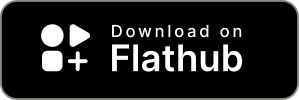A beautiful markdown note-taking app for GNOME (forked from Paper).
Contributions are appreciated, see below for how to help translate Folio!
- Almost WYSIWYG markdown rendering
- Searchable through GNOME search
- Highlight and strike-through text formatting
- Application theming based on notebook color
- Trash can
- Markdown document
- Optional line numbers
- Optional auto save
- Open links with Control-Click
- Link to other notes in Folio
- Automatically create links for bare URL's and e-mail addresses
The recommended way of installing Folio is through Flatpak or Snap:


Go to the current GitHub Releases page, select the latest release, and download the asset called Folio-YY.##.flatpak. Once downloaded, use flatpak install Folio-YY.##.flatpak to install Folio on your computer.
You can use the same process to update to a newer release as well.
The source code is GPLv3
By default, notes are stored in ~/.var/app/com.toolstack.Folio/data,
but that can be changed in preferences
Folio has been translated into several different languages by users. Previously this was done by submitting pull requests to add the various language files.
Folio now has an online localization portal, if you would like to participate in translating Folio, send an e-mail and request access for the language you would like to translate.
Flatpak build requires flatpak-building installed.
- change into the top level source directory
- to configure the build environment (required only once), run
meson build - change into the build directory
- to build Folio, run
ninja - to install Folio, run
ninja install - to run Folio, run
src/com.toolstack.Folio
- install flatpak-builder if not already installed
- change into the top level source directory
- to build the flatpak, run
flatpak-builder --force-clean flatpak com.toolstack.Folio.json - to build and install the flatpak, run
flatpak-builder --user --install --force-clean flatpak com.toolstack.Folio.json - to launch the flatpak, run
flatpak run com.toolstack.Folio
- Install snapcraft if not already installed
- change into the top level source directory
- to build the snap, run
snapcraft - to install locally, run
sudo snap install ./folio_YY.XX_amd64.snap --dangerous - to launch the snap, run
folio
- Install linuxdeploy if not already installed
- change into the top level source directory
- create the directory
AppImage(if it already exists, ensure to remove all of its contents) - change into the build directory
- set the
DESTDIRenvironment variable as follows:export DESTDIR=../AppImage - run build/install with
ninja install - change to the
AppImagedirectory - use linuxdeploy to build the AppImage:
linuxdeploy --appdir=. -d usr/local/share/applications/com.toolstack.Folio.desktop -i usr/local/share/icons/hicolor/scalable/apps/com.toolstack.Folio.svg -e usr/local/bin/com.toolstack.Folio --output appimage - to launch the AppImage, run
Folio-x86_64.AppImage
Folio uses a YY.## version format string, where YY is the two digit year (aka 23, 24, 25, etc) and ## is the release number of the year (aka 01 for the first release, 02 for the second release, etc., not the month number).
The release version is located in the main meson.build file, no other files contain the version number.
The full changelog is located in data/app.metainfo.xml.in and the current release for the about dialog is in src/application.vala.
Once updated, edit the flatpak and snap files:
- change into the top level source directory
- edit
com.toolstack.Folio.jsonand update thetagvalue for sources, also remove thecommithash (don't forget to remove the comma on the line above) temporarily (we'll add it back later) - change into the
snapdirectory - edit
snapcraft.yamland update thesource-tag
Commit everything to git.
Now go to github and do the release.
After the release is done get the hash value for the commit for the new release tag and then add back the commit line in com.toolstack.Folio.json. Commit it back to git as well.
Two actions should have been kicked off on the github release, one to build the flatpak and the other to build the snap. These will take a few minutes to complete, but once they do, go to each one and download the built assets.
You will need to build the AppImage manually, follow the instructions above on how to do that and retrieve the generated Folio-x86_64.AppImage file.
Extract both zips that you downloaded and rename the resulting flatpak/snap/AppImage to "Folio=YY.XX.[flatpak/snap/AppImage]".
Go back to the release and attach these files to the release assets.
Now do the releases on Flathub and Snapcraft.
- get a clone of the flathub repo:
https://github.com/flathub/com.toolstack.Folio.git - create a new branch labeled "YY.XX"
- switch to the new branch
- edit
com.toolstack.Folio.jsonand update both thetagandcommitlines to reflect the new release - commit the changes
- go to github and create a new PR to merge the branch into master
- commit the PR
- after build, login to your snapcraft account
snapcraft login - upload the build
snapcraft upload --release=stable folio_YY.##_amd64.snap
Folio uses POT/PO files for it's translations, the POT file defines all the strings that are used by Folio.
Before generating the POT file you must have already run meson for the first time and have run a local build.
To generate the POT file:
- change into the PO directory
- run
./print-source-files.sh > POTFILES - change into the build directory:
cd ../build - run
meson compile com.toolstack.Folio-pot
Unfortunately Paper is out of date and the developer does not have the time/interest to maintain it any more.
The primary focus of my fork is getting everything up to date and supported for the long term.
A secondary focus is feature additions. Some new features that have already been added are:
- Better handling of escaped characters in code spans.
- Reworking of the format bar to act more like use user expect, including toggling formatting and smarter formatting.
- Control-click to open links in a browser.
- Marking non-markdown formatted links and email addresses.
- Fixed a ton of crashes caused by files without ending EOL markers.
- Automatically pace inserted formatting around current words instead of in the middle of them.